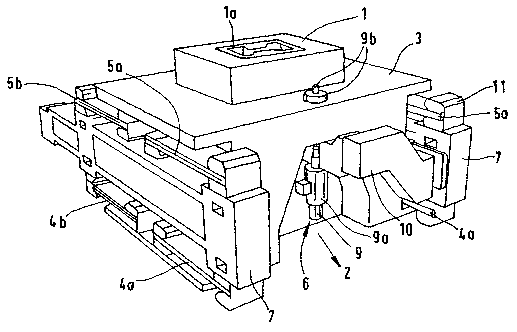Some of the information on this Web page has been provided by external sources. The Government of Canada is not responsible for the accuracy, reliability or currency of the information supplied by external sources. Users wishing to rely upon this information should consult directly with the source of the information. Content provided by external sources is not subject to official languages, privacy and accessibility requirements.
Any discrepancies in the text and image of the Claims and Abstract are due to differing posting times. Text of the Claims and Abstract are posted:
| (12) Patent Application: | (11) CA 2395634 |
|---|---|
| (54) English Title: | DEVICE FOR THE CONTINUOUS CASTING OF METALS, ESPECIALLY STEEL |
| (54) French Title: | DISPOSITIF DE COULEE CONTINUE DE METAUX, EN PARTICULIER D'ACIER |
| Status: | Deemed Abandoned and Beyond the Period of Reinstatement - Pending Response to Notice of Disregarded Communication |
| (51) International Patent Classification (IPC): |
|
|---|---|
| (72) Inventors : |
|
| (73) Owners : |
|
| (71) Applicants : |
|
| (74) Agent: | RICHES, MCKENZIE & HERBERT LLP |
| (74) Associate agent: | |
| (45) Issued: | |
| (86) PCT Filing Date: | 2001-05-05 |
| (87) Open to Public Inspection: | 2001-11-15 |
| Availability of licence: | N/A |
| Dedicated to the Public: | N/A |
| (25) Language of filing: | English |
| Patent Cooperation Treaty (PCT): | Yes |
|---|---|
| (86) PCT Filing Number: | PCT/EP2001/005117 |
| (87) International Publication Number: | WO 2001085370 |
| (85) National Entry: | 2002-06-25 |
| (30) Application Priority Data: | ||||||
|---|---|---|---|---|---|---|
|
The invention relates to a device for the continuous casting of metals,
especially steel, by means of a continuous casting mould (1) which is mounted
in an oscillating frame (3). Said oscillating frame can be driven so that it
oscillates in the direction of casting (2), the course of the oscillation
movement and/or the frequency being adjustable. The oscillating frame (3) is
mounted with spring assemblies (4a, 4b; 5a, 5b) arranged symmetrically on both
sides of the strand, for guiding and weight compensation. The device is used
on a continuous casting mould (1) with a shaped casting cross-section (1a),
which is mounted in the oscillating frame (3). The leaf-spring-mounted
oscillating frame (3) can be operated with the continuous casting mould (1) in
a resonance oscillation method in order to give the preliminary section a
better surface.
La présente invention concerne un dispositif de coulée continue de métaux, en particulier d'acier, au moyen d'une coquille de coulée continue (1) qui est disposée dans un bâti oscillant (3) pouvant être entraîné en oscillation dans une direction de coulée (2). Selon l'invention, la course du mouvement d'oscillation et/ou la fréquence sont réglables et le bâti oscillant (3) est disposé de manière à permettre le guidage et la compensation de poids, au moyen d'ensembles de ressorts (4a, 4b; 5a, 5b) disposés symétriquement aux deux extrémités de la veine de coulée. Ledit dispositif de coulée est utilisé sur une coquille de coulée continue (1) à section de coulée profilée (1a), disposée dans le bâti oscillant (3), le bâti oscillant (3) monté sur ressorts à lames, pouvant être entraîné avec la coquille de coulée continue (1) dans le processus d'oscillation de résonance, afin de donner au profilé une surface de meilleure qualité.
Note: Claims are shown in the official language in which they were submitted.
Note: Descriptions are shown in the official language in which they were submitted.

2024-08-01:As part of the Next Generation Patents (NGP) transition, the Canadian Patents Database (CPD) now contains a more detailed Event History, which replicates the Event Log of our new back-office solution.
Please note that "Inactive:" events refers to events no longer in use in our new back-office solution.
For a clearer understanding of the status of the application/patent presented on this page, the site Disclaimer , as well as the definitions for Patent , Event History , Maintenance Fee and Payment History should be consulted.
| Description | Date |
|---|---|
| Inactive: IPC from MCD | 2006-03-12 |
| Application Not Reinstated by Deadline | 2004-05-05 |
| Time Limit for Reversal Expired | 2004-05-05 |
| Appointment of Agent Requirements Determined Compliant | 2004-04-21 |
| Inactive: Office letter | 2004-04-21 |
| Inactive: Office letter | 2004-04-21 |
| Revocation of Agent Requirements Determined Compliant | 2004-04-21 |
| Appointment of Agent Request | 2004-04-13 |
| Revocation of Agent Request | 2004-04-13 |
| Deemed Abandoned - Failure to Respond to Maintenance Fee Notice | 2003-05-05 |
| Letter Sent | 2002-12-12 |
| Inactive: Courtesy letter - Evidence | 2002-11-05 |
| Inactive: Cover page published | 2002-11-04 |
| Inactive: Notice - National entry - No RFE | 2002-10-29 |
| Inactive: Single transfer | 2002-10-23 |
| Application Received - PCT | 2002-09-10 |
| National Entry Requirements Determined Compliant | 2002-06-25 |
| Application Published (Open to Public Inspection) | 2001-11-15 |
| Abandonment Date | Reason | Reinstatement Date |
|---|---|---|
| 2003-05-05 |
| Fee Type | Anniversary Year | Due Date | Paid Date |
|---|---|---|---|
| Basic national fee - standard | 2002-06-25 | ||
| Registration of a document | 2002-10-23 |
Note: Records showing the ownership history in alphabetical order.
| Current Owners on Record |
|---|
| SMS DEMAG AKTIENGESELLSCHAFT |
| Past Owners on Record |
|---|
| ADOLF ZAJBER |
| LOTHAR FISCHER |
| SIEGBERT SCHWENECKE |
| THOMAS FEST |